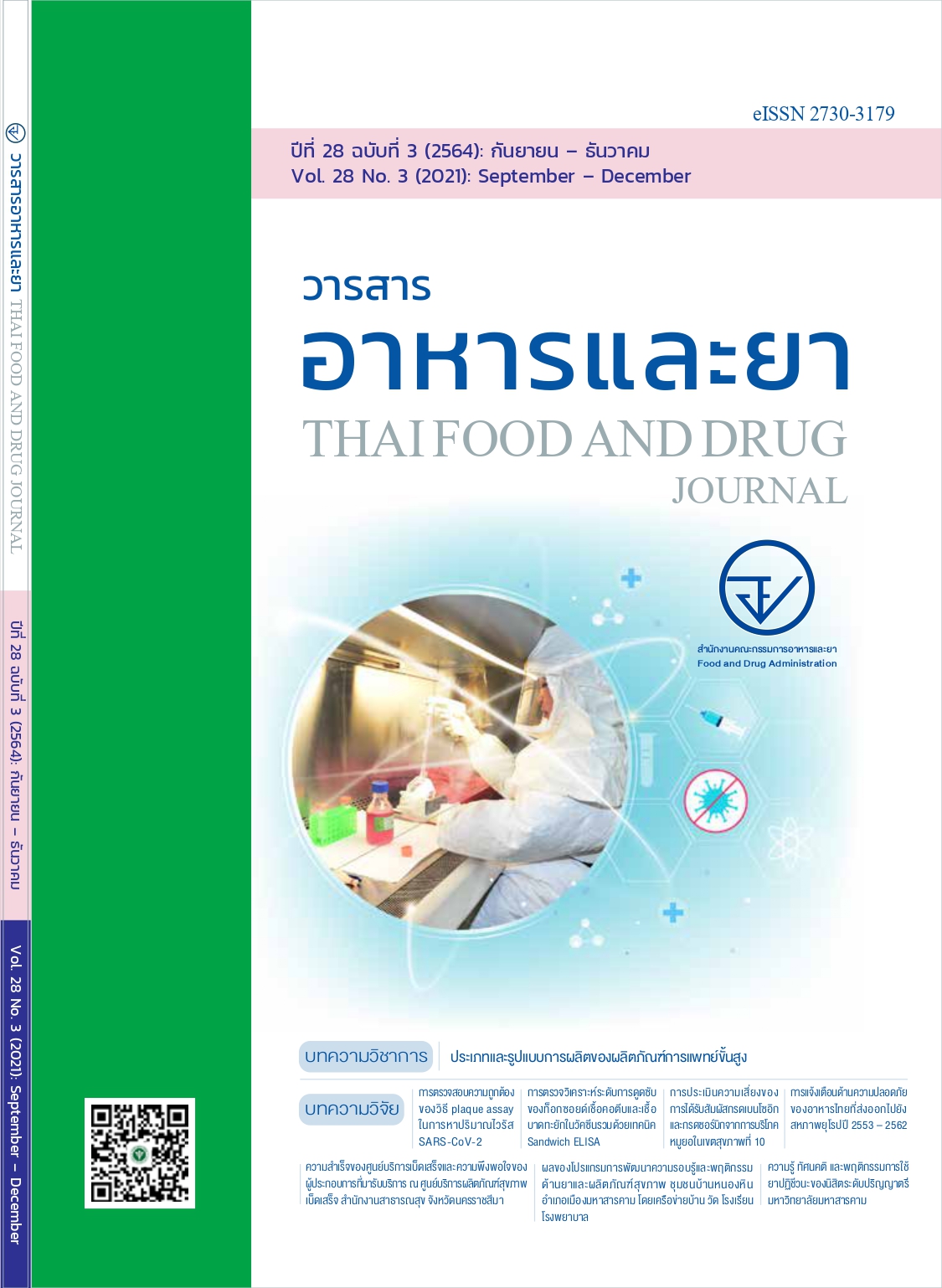การประเมินความเสี่ยงของการได้รับสัมผัสกรดเบนโซอิกและกรดซอร์บิกจากการบริโภคหมูยอในเขตสุขภาพที่ 10
Main Article Content
บทคัดย่อ
ความสำคัญ: หมูยอเป็นผลิตภัณฑ์เนื้อสัตว์แปรรูปที่มีชื่อเสียงและนิยมซื้อเป็นของฝาก มีแหล่งผลิตขนาดใหญ่ในจังหวัดอุบลราชธานีและจังหวัดใกล้เคียง ประกาศกระทรวงสาธารณสุข (ฉบับที่ 418) พ.ศ. 2563 เรื่อง กำหนดหลักเกณฑ์ เงื่อนไข วิธีการใช้ และอัตราส่วนของวัตถุเจือปนอาหาร (ฉบับที่ 2) ไม่กำหนดปริมาณสูงสุดในการใช้กรดเบนโซอิก ส่วนกรดซอร์บิกใช้ได้ไม่เกิน 1,500 mg/kg แต่จากการตรวจเฝ้าระวังทางห้องปฏิบัติการพบว่ายังมีการใช้วัตถุกันเสียทั้งสองชนิด
วัตถุประสงค์: เพื่อศึกษาสถานการณ์การใช้วัตถุกันเสียชนิดกรดเบนโซอิกและกรดซอร์บิกในหมูยอ และประเมินความเสี่ยงของการได้รับสัมผัสกรดเบนโซอิกและกรดซอร์บิกจากการบริโภคหมูยอ
วิธีการวิจัย: สุ่มเก็บตัวอย่างหมูยอจากแหล่งผลิตและจำหน่ายในจังหวัดอุบลราชธานี ศรีสะเกษ มุกดาหาร ยโสธร และอำนาจเจริญ ระหว่างเดือนธันวาคม 2562 – มิถุนายน 2563 จำนวน 114 ตัวอย่าง ตรวจวิเคราะห์กรดเบนโซอิกและกรดซอร์บิกในหมูยอด้วยวิธี High performance liquid chromatography นำข้อมูลผลวิเคราะห์ที่ได้ประเมินความเสี่ยงการได้รับสัมผัสกรดเบนโซอิกและกรดซอร์บิกจากการบริโภคหมูยอของคนไทยในกลุ่มอายุต่าง ๆ โดยวิธี Probabilistic estimation แบ่งกลุ่มผู้บริโภคเป็น กลุ่มประชากรทั้งหมด และกลุ่มชอบบริโภค
ผลการศึกษา: หมูยอจำนวน 114 ตัวอย่าง ตรวจพบกรดเบนโซอิก และกรดซอร์บิก จำนวน 84 และ 10 ตัวอย่าง โดยมีปริมาณต่ำสุด-สูงสุดอยู่ในช่วง 9-4,168 และ 108-1,253 mg/kg ตามลำดับ พบทั้งกรดเบนโซอิกและกรดซอร์บิกจำนวน 1 ตัวอย่าง มีปริมาณ 442 และ 108 mg/kg ตามลำดับ ผลจากการประเมินการได้รับสัมผัสกรดเบนโซอิกมีความเสี่ยงต่ำในกลุ่มประชากรทั้งหมดที่ระดับเฉลี่ยคิดเป็นร้อยละ 0.77-3.20 ของค่า ADI ระดับสูงที่ 97.5 เปอร์เซ็นไทล์ คิดเป็นร้อยละ 25.62-85.61 ของค่า ADI และกลุ่มเฉพาะผู้ชอบบริโภคมีความเสี่ยงต่ำเมื่อได้รับสัมผัสกรดเบนโซอิกที่ระดับเฉลี่ย คิดเป็นร้อยละ 16.74-49.25 ของค่า ADI ผลการประเมินความเสี่ยงระดับสูงที่ 97.5 เปอร์เซ็นไทล์ ของกลุ่มเฉพาะผู้บริโภคมีความเสี่ยงสูงในทุกกลุ่มอายุ คิดเป็นร้อยละ 157.46-579.90 ของค่า ADI
สรุป: หมูยอส่วนใหญ่ในเขตสุขภาพที่ 10 มีการใช้กรดเบนโซอิกซึ่งมีความเสี่ยงสูงต่อการได้รับสัมผัสกรดเบนโซอิกต่อกลุ่มผู้บริโภคเฉพาะทุกกลุ่มอายุ ดังนั้นเพื่อความปลอดภัยหน่วยงานที่เกี่ยวข้องควรมีการควบคุมการใช้วัตถุเจือปนตามที่กฎหมายกำหนดและสื่อสารประชาสัมพันธ์ให้ความรู้แก่ผู้บริโภคเพื่อประกอบการตัดสินใจในการเลือกซื้อหมูยอต่อไป
Article Details

อนุญาตภายใต้เงื่อนไข Creative Commons Attribution-NonCommercial-NoDerivatives 4.0 International License.
เอกสารอ้างอิง
สำนักงานมาตรฐานผลิตภัณฑ์อุตสาหกรรรม กระทรวงอุตสาหกรรม. มาตรฐานผลิตภัณฑ์ชุมชน มผช.102/2555 หมูยอ [อินเทอร์เน็ต]. กรุงเทพฯ: สำนักงานมาตรฐานผลิตภัณฑ์อุตสาหกรรม; 2555 [เข้าถึงเมื่อ 5 มี.ค. 2562]. เข้าถึงได้จาก: http://tcps.tisi.go.th/pub/tcps0102_55(%E0%B8%AB%E0%B8%A1%E0%B8%B9%E0%B8%A2%E0%B8%AD).pdf
สุกิจ นววงศ์. Food additives hand book: คู่มือวัตถุเจือปนอาหาร. กรุงเทพฯ: เอมี่ เทรดดิ้ง; 2548.
อัญชนา ดุจจานุทัศน์. การยืดอายุการเก็บรักษาหมูยอโดยใช้โซเดียมเบนโซเอต [อินเทอร์เน็ต]. กรุงเทพ: ภาควิชาอาหารเคมี คณะเภสัชศาสตร์ จุฬาลงกรณ์มหาวิทยาลัย; 2545 [เข้าถึงเมื่อ 1 เม.ย. 2564]; 58-66.เข้าถึงได้จาก: http://cuir.car.chula.ac.th/handle/123456789/65397
กระทรวงสาธารณสุข. ประกาศกระทรวงสาธารณสุข (ฉบับที่ 418) พ.ศ. 2563 เรื่อง กำหนดหลักเกณฑ์ เงื่อนไข วิธีการใช้ และอัตราส่วนของวัตถุเจือปนอาหาร (ฉบับที่ 2). ราชกิจจานุเบกษา ฉบับประกาศ ทั่วไป เล่มที่ 137, ตอนพิเศษ 278 ง (ลงวันที่ 2 กันยายน 2563).
Food and Agriculture Organization of the United Nations, World Health Organization. Evaluations of The Joint FAO/WHO Expert Committee on Food Additives (JECFA) [Internet]. Geneva, Switzerland. 2017 [cited 2019 Mar 2]. Available from: https://apps.who.int/food-additives-contaminants-jecfa-database/search.aspx
สุวรรณี ธีรภาพธรรมกุล และคณะ. การประเมินความเสี่ยงของกรดเบนโซอิคและกรดซอร์บิคในอาหารต่อคนไทย. วารสารวิชาการสาธารณสุข [อินเทอร์เน็ต]. 2559 [เข้าถึงเมื่อ 21 ส.ค. 2562]; 25(1):49-59. เข้าถึงได้จาก: https://www.thaidj.org/index.php/JHS/article/view/224/216
นงคราญ เรืองประพันธ์ และคณะ. การใช้วัตถุเจือปนอาหารและการดื้อยาต้านจุลชีพของเชื้อ Staphylococcus aureus และ Salmonella spp. ที่ปนเปื้อนในผลิตภัณฑ์เนื้อสัตว์แปรรูปใน 15 จังหวัดประเทศไทย. วารสารอาหารและยา [อินเทอร์เน็ต]. 2563 [เข้าถึงเมื่อ 10 พ.ค. 2563]; 27(1):27-40. เข้าถึงได้จาก: https://he01.tci-thaijo.org/index.php/fdajournal/article/view/240388/163688
ปวีณ์ดา ศรีพนารัตนกุล, เวณิกา เบ็ญจพงษ์, ปิยนุช วิเศษชาติ, ปราณี พัฒนกุลอนันต์, วีรยา การพานิช. การประเมินความเสี่ยงของการได้รับสัมผัสกรดเบนโซอิกและกรดซอร์บิกจากการบริโภคอาหารประเภทไส้กรอกและหมูยอของคนไทย. วารสารพิษวิทยาไทย [อินเทอร์เน็ต]. 2552 [เข้าถึงเมื่อ 12 ก.ค. 2562]; 24(1):27-36. เข้าถึงได้จาก: https://li01.tci-thaijo.org/index.php/ThaiJToxicol/article/view/243810/166429
บุญสงค์ ลี้สุรพลานนท์. การศึกษาสถานการณ์การใช้วัตถุเจือปนอาหารในผลิตภัณฑ์จากเนื้อสัตว์ จังหวัดนครราชสีมา 2560. วารสารอาหารและยา [อินเทอร์เน็ต]. 2561 [เข้าถึงเมื่อ 8 ส.ค. 2562]; 25(1):58-66. เข้าถึงได้จาก: https://he01.tci-thaijo.org/index.php/fdajournal/article/view/140345/104105
วันทนีย์ ขำเลิศ. การวิเคราะห์ปริมาณกรดเบนโซอิก กรดซอร์บิก และซัคคารินในผลไม้แปรรูป. วารสารกรมวิทยาศาสตร์การแพทย์ 2535;34(1):31-36.
สำนักงานมาตรฐานสินค้าและระบบคุณภาพ. ข้อมูลการบริโภคอาหารของประเทศไทย [อินเทอร์เน็ต]. กรุงเทพฯ: สำนักงานมาตรฐานสินค้าเกษตรและอาหารแห่งชาติ กระทรวงเกษตรและสหกรณ์; 2559. [เข้าถึงเมื่อ 5 มี.ค. 2562]; เข้าถึงได้จาก: http://www.thaincd.com/document/file/info/non-communicable-disease/Thai_Food_Consumption_Data_2016.pdf
กระทรวงสาธารณสุข. ประกาศกระทรวงสาธารณสุข (ฉบับที่ 389) พ.ศ.2561 เรื่อง วัตถุเจือปนอาหาร.
ราชกิจจานุเบกษา ฉบับประกาศ ทั่วไป เล่มที่ 135, ตอนพิเศษ 178 ง (ลงวันที่ 25 กรกฎาคม 2561).
ยศยา ทุริสุทธิ์, อรรณพ ทัศนอุดม, ลัดดา วัฒนศิริธรรม, ฆรณี ตุ้ยเต็มวงศ์, วราภา มหากาญจนกุล. การ
ต้านทานกรดเบนโซอิกของ Aspergillus flavus ในน้ำพริกตาแดง. วารสารวิทยาศาสตร์มหาวิทยาลัยขอนแก่น [อินเทอร์เน็ต]. 2559 [เข้าถึงเมื่อ 1 เม.ย. 2564]; 44(1):11-23. เข้าถึงได้จาก:
http://scijournal.kku.ac.th/files/Vol_44_No_1_P_111-123.pdf
เวณิกา เบ็ญจพงษ์ และคณะ. การประเมินการได้รับ สัมผัสกรดเบนโซอิกจากการบริโภคเนื้อสัตว์และสัตว์น้ำแปรรูป ขนมอบและเครื่องดื่มในผลิตภัณฑ์กลุ่มเสี่ยงที่ประชากรไทยนิยมบริโภค. วารสารพิษวิทยาไทย
[อินเทอร์เน็ต]. 2556. [เข้าถึงเมื่อ 1 เม.ย. 2564]; 28(2):1-16. เข้าถึงได้จาก:
https://li01.tci-thaijo.org/index.php/ThaiJToxicol/article/view/244085/166680
อุไรพร สอนสุภาพ, อนุสรา ศรีภา, จิรา คงปราณ, ประเสริฐ มากแก้ว. การประเมินความเสี่ยงต่อสุขภาพ
ของการได้รับสัมผัสกรดเบนโซอิกและกรดซอร์บิกจากการบริโภคก๋วยเตี๋ยวในนักศึกษามหาวิทยาลัย.
[อินเทอร์เน็ต]. 2563. [เข้าถึงเมื่อ 1 เม.ย. 2564]; เข้าถึงได้จาก: https://li01.tci-thaijo.org/index.php/ThaiJToxicol/article/download/245021/167508
กิตติมา โสนะมิตร์, วันทนีย์ ขำเลิศ. ปริมาณโซเดียมเบนโซเอตและสีอินทรีย์สังเคราะห์ในอาหาร.
วารสารกรมวิทยาศาสตร์การแพทย์ [อินเทอร์เน็ต]. 2522. [เข้าถึงเมื่อ 1 เม.ย. 2564]; 51(2):170-175.
อลิสรา เรืองขำ. พัชรินทร์ วัฒนสิน. การประเมินความเสี่ยงของการได้รับสัมผัส วัตถุกันเสีย สีอินทรีย์ สังเคราะห์และเชื้อจุลินทรีย์จากการบริโภคเนื้อสัตว์แปรรูปประเภทเนื้อหมักในจังหวัดตรัง.วารสารวิชาการสาธารณสุข [อินเทอร์เน็ต]. 2563 [เข้าถึงเมื่อ 1 เม.ย. 2564]; 29(5):830-838. เข้าถึงได้จาก:
https://thaidj.org/index.php/JHS/article/view/9474/8714
พัชริดา พิชัย, นฤมล ขันตีกุล. การประเมินการได้รับสัมผัสของกรดเบนโซอิกในน้ำพริกหนุ่มที่จำหน่ายใน จังหวัดเชียงใหม่ ปี พ.ศ. 2553-2556 [อินเทอร์เน็ต]. 2558 [เข้าถึงเมื่อ 1 เม.ย. 2564]; ฉบับพิเศษ 2: 198-207. เข้าถึงได้จาก: http://dmsc.moph.go.th/dmscjournal/knowledge_detail.php?cid=22&id=132
พัจนภา วงษาพรหม, เวณิกา เบ็ญจพงษ์, วีรยา การพานิช, ปราณี พัฒนกุลอนันต์. การประเมินความเสี่ยงของการได้รับสัมผัสกรดเบนโซอิกและกรดซอร์บิก จากการบริโภคเครื่องแกงเผ็ดของประชากรในเขต กรุงเทพมหานคร และสุพรรณบุรี. วารสารพิษวิทยาไทย [อินเทอร์เน็ต]. 2552 [เข้าถึงเมื่อ 1
เม.ย. 2564]; 24(1):17-26. เข้าถึงได้จาก: https://li01.tci-
thaijo.org/index.php/ThaiJToxicol/article/view/243809/166428


